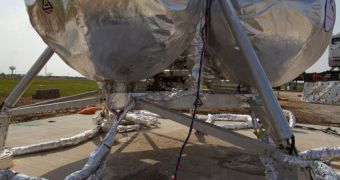Officials from the American space agency announce that engineers are working on refining new technologies that could be used for space exploration. Particularly, their goal is to enable the creation of a new generation of robotic landers that could be sent to numerous locations in the solar system.
One of the long-term goals in space exploration is visiting planets and moons in our solar system in an affordable manner, using technologies that have a very high percentage of success. However, this has proven difficult to do until now, as space flight still remains very expensive.
NASA has been working towards solving this problem for many years, and the new robotic landers are its answer to the challenges that lie ahead. The cutting-edge technology being developed here may one day be converted for manned spaceflight as well.
The Morpheus project is perhaps the most important new initiative NASA has. Based at the agency's Johnson Space Center (JSC), in Houston, Texas, the project seeks to create a robotic lander that can hover above the ground before touching down.
For the past few months, the machine has been put through its paces at JSC's testing grounds, and two consecutive, tethered test flights are scheduled to take place soon. In past tests, an oversight started a bush fire near the lander's launch site, prompting some delays.
Morpheus engineer Tim Crain says that the new safety measures are now in place at the landing site. “Basically, it’s a set of independent power, radios and valves we can use to close off feed to the main engine to end flight if all else fails,” Crain he tells Space in an interview.
“We have three primary systems on the vehicle that do the same. This is all geared around ensuring safety for the JSC work force and surrounding population while we are doing low-energy free flights in Houston,” the expert adds.
The second main project is the Robotic Lander Development Project, which is based at the Marshall Space Flight Center (MSFC), in Huntsville, Alabama. The machine already completed its second untethered test flight and is now gearing up for even more free-flight tests.
“With each test flight the lander is stabilizing, flying longer and demonstrating its control algorithms can maintain a stable attitude and execute a soft landing using the system's pulsing thrusters,” a press release from NASA reads.
In addition to testing sensors, flight software and landing techniques, these two landers are also demonstrating alternative launch, hover and land methods, which can be achieved at lower costs.
If successful, these two projects may enable the machines to hover from one location to the other on the surface of Mars or the Moon, achieving capabilities that earlier space missions could only dream of.

 14 DAY TRIAL //
14 DAY TRIAL //